10 Artists Worth Knowing From Banksy's Dismaland
A look at some of the names behind the “festival of art, amusements and entry-level anarchism.”
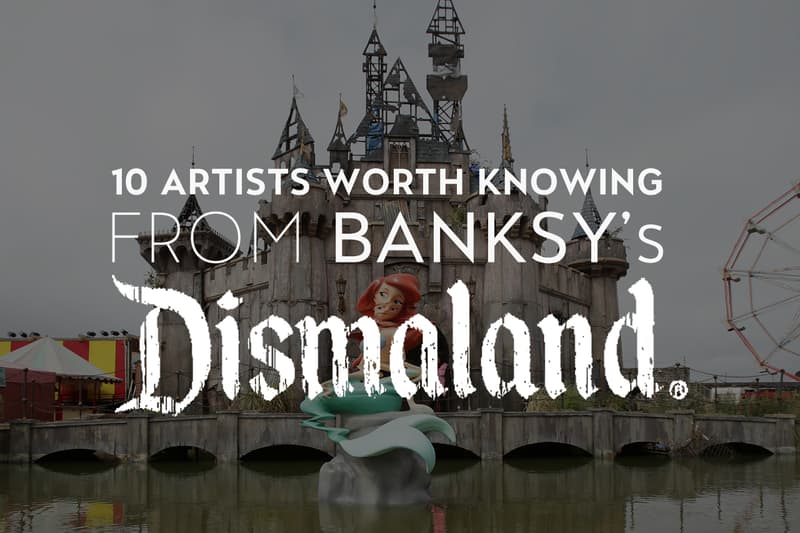
Opening just last weekend to worldwide fanfare was the most audacious installation yet by a figure known for audacity — Banksy’s Dismaland is a full-blown “bemusement park” spanning 10,200 square feet in the nondescript English seaside town of Weston-Super-Mare, and nothing like what the world had seen before from the world of anti-establishment art. Not only has Dismaland captured the public consciousness for its blatant subversion (and perversion) of the much-loved Disney empire, but Banksy’s vision for “a place where you can get your counterculture easily available over the counter” has been bolstered by a significant troop of the art world’s enfants terrible — 58 of them, in fact. Here, we introduce ten of Banksy’s chosen who deserve mention for their aptitude in calling out society for its worst facets — with no shortage of scathing satire.
Lush
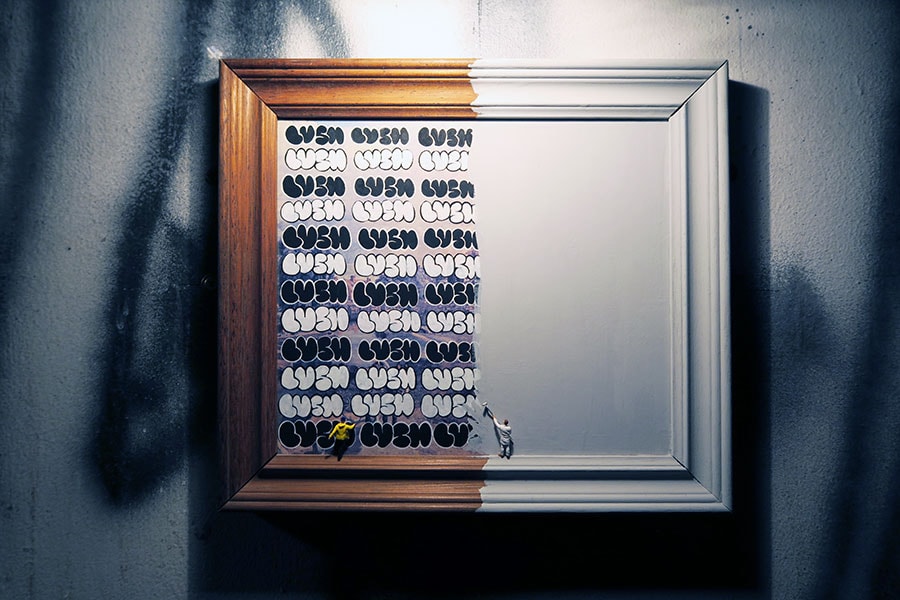
Known rather unceremoniously as the “graffiti asshole,” Australian street artist Lush has garnered a loyal following for his uniquely crass brand of humor, most times bordering on disgust. The Melbourne native frequently portrays shocking elements in his pieces, such as nudity, cussing and bodily excretions, interwoven with self-deprecating wit and sarcasm throughout — on occasion he has referred to his own work as “terrible, terrible garbage; horrid, festering trash.” His work appearing in Dismaland is surprising, given that Banksy was often a target of Lush’s work, where Lush would heavily modify the British artist’s pieces to become his own. A multitalented artist, Lush frequently posts his own doodles and videos on Instagram that are bitingly critical and make a mockery of other graffiti artists, the purpose and culture of street art, social media, and society as a whole.
Jessica Harrison
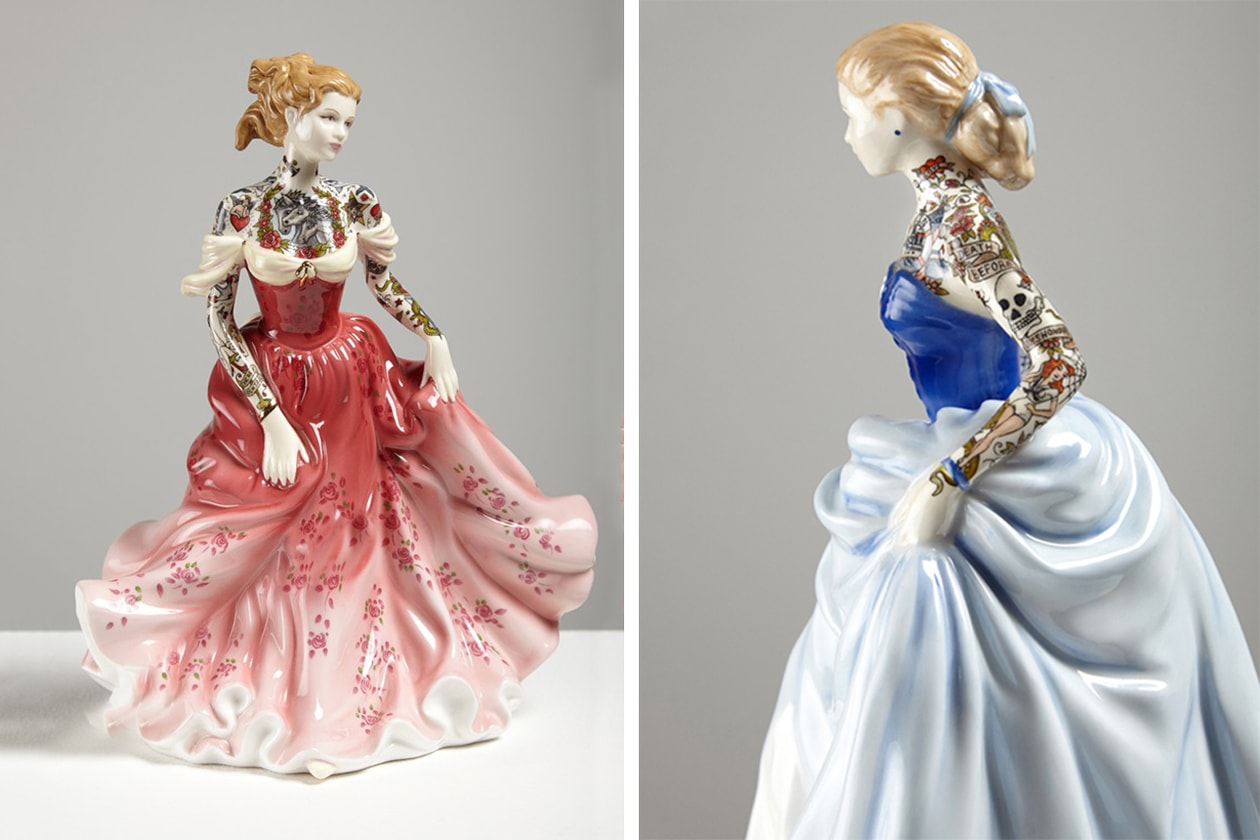
Many of the artists featured in Dismaland deal with the uncomfortable amalgamation of polar opposites in their work, and among the most shocking are the porcelain figurines of Jessica Harrison. Holding a PhD in Sculpture at the Edinburgh College of Art, the English artist is most well known for adding jarring or disturbing elements to the medium of kitschy Victorian-style porcelain female figures in ball gowns — those in the Painted Lady series shown at Dismaland sport unmissable sailor tattoos head-to-toe, while another series is decidedly more gruesome with the porcelain dolls having been afflicted with slit throats, gouged eyes, dismembered limbs, and the like. Throughout the rest of her body of work, Harrison explores the relation between interior and exterior spaces of the body — across her many chosen mediums of porcelain, clay, silk, stone and silicone, the merging of bodily components such as skin and entrails with everyday objects creates a deeply unsettling and disturbing effect.
Maskull Lasserre
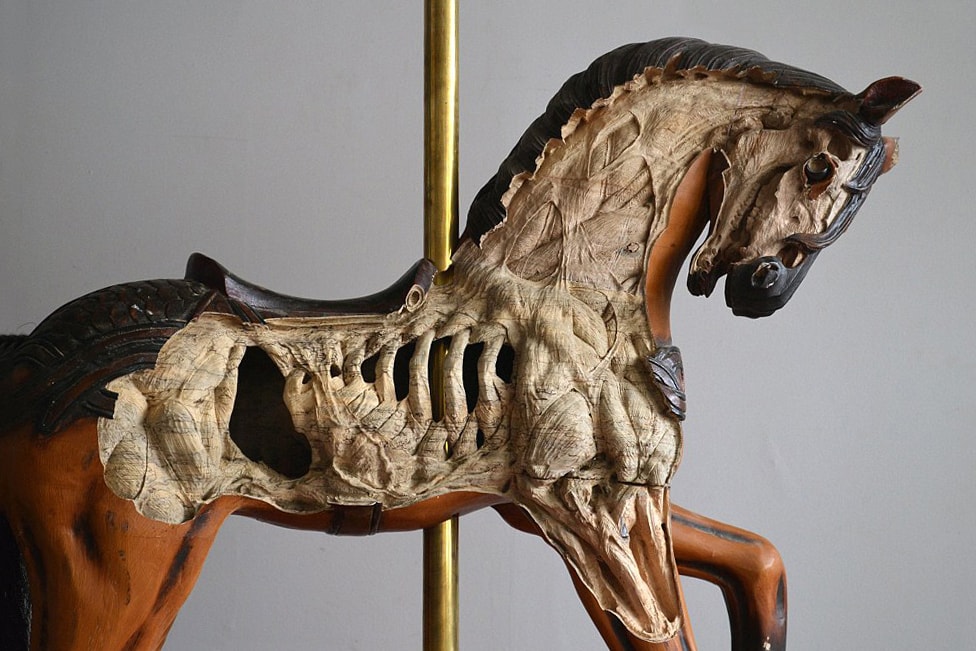
In a similar vein to Harrison, Montreal-born carpenter Maskull Lasserre brings elements of the biological and macabre to otherwise inanimate objects, in many instances carving human or animal-shaped figurines just below the surface to unveil a startlingly intricate anatomy of complex muscle and bone. In another series titled “Fable,” Lasserre perches objects such as an axe atop a chair, and at the point that they meet, he carves a diminuitive animal skeleton out of the wood. Speaking on his use of death-related motifs in everyday objects, Lasserre says that “when the remnants of life are imposed on an object, it infers a past history or a previous life that had been lived … [so] by imparting these bodily elements to inanimate objects it reclaims or reanimates them in a virtual way.” While not overtly political, the art of both Harrison and Lasserre serves to stop people in their tracks and question superficiality in society through the use of visual metaphor, encouraging them to look for something more than skin-deep.
Damien Hirst
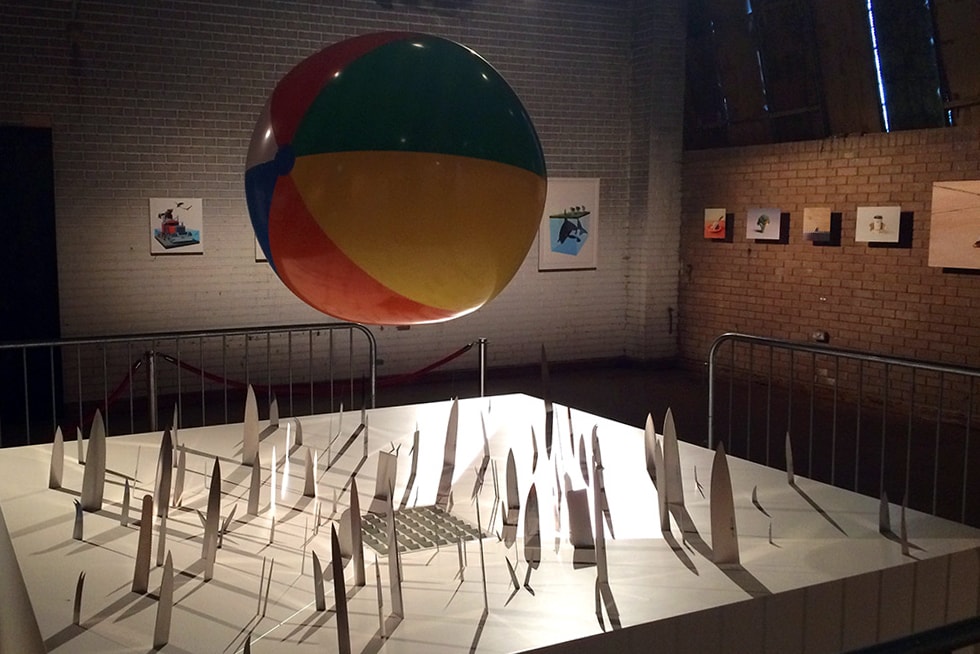
Damien Hirst is perhaps the most well-known out of the collaborators. Purportedly Britain’s richest living artist, Hirst made a name for himself with his grotesque pieces involving preserved and dissected dead animals, most notably The Physical Impossibility of Death in the Mind of Someone Living, which sold for $12 million USD to a private art collector. Hirst has been compared to the likes of Andy Warhol, not only for breaking ground in his various mediums, but also for his unbridled use of assistants and a factory-like setup to create his pieces — to this, Hirst has said that the artist is the mind that conceives of the art, and not necessarily the hand that creates it.
Like Warhol, Hirst has also been accused of plagiarism and appropriation of other artists’ work, leading to numerous lawsuits against him in the process. Hirst’s body of work overwhelmingly concerns itself with the concepts of death and mortality, whilst simultaneously holding a mirror back at the money-driven character of the art market for the preposterous sums his pieces sell for. Banksy and Hirst have collaborated on numerous pieces that play off each other’s artistic styles, so much so that conspiracy theories have arisen on Banksy receiving his funding from Hirst himself, which this latest collaboration does little to quell — Hirst’s Dismaland piece, The History of Pain, is shown above.
ESPO
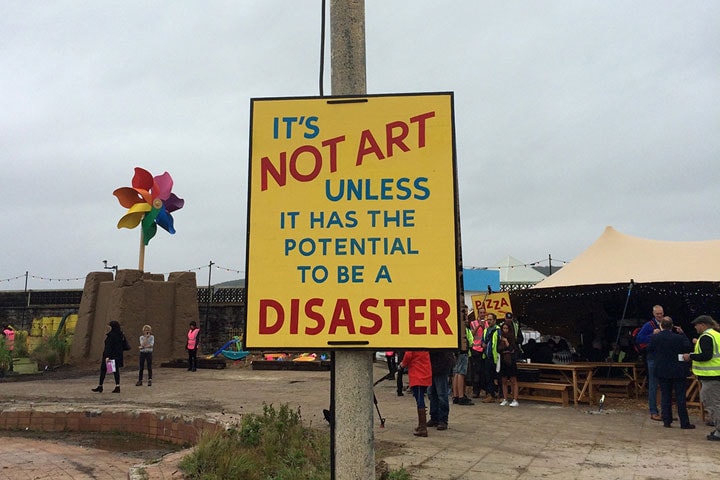
Having established himself in the New York graffiti scene since the mid-’90s, Stephen Powers revives his famed moniker ESPO at Dismaland. ESPO, short for Exterior Surface Painting Outreach, came to be defined by his street art treading the line between legality and illegality, with his style coming to resemble official-seeming signs carrying not-so-official messages, as demonstrated by his Dismaland piece above. In his heyday in the late ’90s, ESPO’s romping grounds covered Philadelphia, various neighborhoods in New York and Brooklyn, where he would paint over gates, in the process posing as an employee of the aforementioned Exterior Surface Painting Outreach when questioned by passers-by. A run-in with the law in 1999 — the artist claims that his subsequent arrest was politically motivated for his work defaming then New York mayor Rudolph Giuliani — led to ESPO leaving the graffiti world and becoming a full-time studio artist. Being based almost entirely on typography, his art aims to clearly communicate heritage and community-centered messages to the neighborhoods in which they are painted.
Jimmy Cauty
Having achieved fame in music as one half of the phenomenally popular acid house band The KLF, and infamy for burning their earnings of £1 million GBP in 1994, Jimmy Cauty now functions as an anti-establishment artist drawing attention to subjects such as the police state and the War on Terror. His piece shown at Dismaland (video above) is The Aftermath Dislocation Principle, Part One: A Small World Re-enactment – a massive, 448-square-foot installation depicting the dystopian aftermath of a crazed riot in London, where the landscape is deserted apart from 3,000 policemen idling around, designed to “[make] a political statement about societal freedom and state control.” This dovetails perfectly with Banksy’s own artistic sentiments which are fiercely opposed to the militarization of society, not to mention the gradual suffocation of individual liberties under a tightening rule of law.
Paco Pomet

Based in Grenada, Spain, Paco Pomet exhibits the same subversive sense of humor that has qualified many of the other artists for Dismaland, which he applies to reworking both vintage and modern photographs into thoroughly surreal compositions. Oftentimes, his oil paintings seem like undoctored photographs from afar, but come closer, and it becomes apparent that something is very much out of place. His works shown at the Bemusement Park were organized along the theme of environmental degradation at the hands of humans — one composition showed blood pouring out of trees that lumberjacks had sawn in half, while another depicted a peaceful mountain range slowly being subsumed by a cartoonish, yet undeniably sinister purple sludge overcoming the mountain peaks.
Jenny Holzer
Akin to ESPO in that much, if not all of her work is heavily text-based, Jenny Holzer can be considered a relative heavyweight in the art world, given her career spanning almost three and a half decades, as well as being the first female artist representing the U.S. to exhibit at the Venice Biennale. Often attributed a feminist lean, Holzer’s work often encompass large-scale installations that use narrative or commentary as an art form. While her pre-2001 work incorporated phrases she conceived herself, her more recent work uses phrases lifted from elsewhere — such as from declassified interrogations of American soldiers from Abu Ghraib — always in a deadpan tone that intends to subvert a patriarchal and capitalist society. Like Banksy, this dark humor-laden political approach is evident throughout the bodies of work by both artists.
Pure Evil
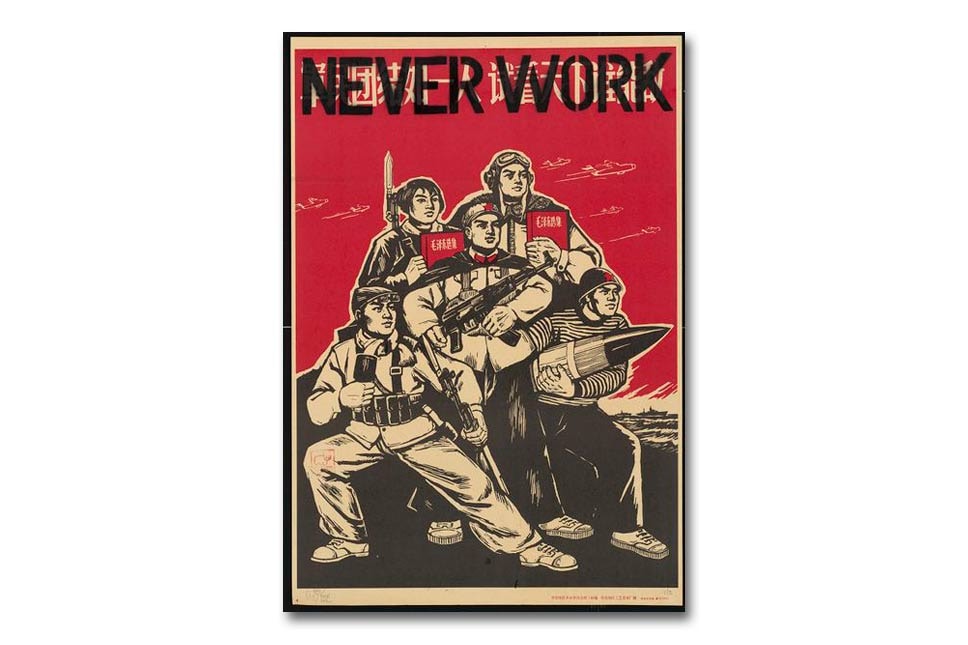
A contemporary of Banksy, Pure Evil is the moniker of Charles Uzzell-Edwards, who gained notoriety in the 2000s for spray painting his signature fanged bunny everywhere in London. After becoming involved with Banksy’s Stable Ghetto project, Pure Evil founded the Pure Evil Gallery in the city’s Shoreditch neighborhood, which has since become a staging point for many of London’s graffiti and street artists. His series exhibited at Dismaland reappropriates Mao-era propaganda from the Cultural Revolution, replacing the posters’ call to action with one that subverts its meaning — similar to Banksy’s pieces that reappropriate images of the British state, such as the Queen.
Shadi Alzaqzouq
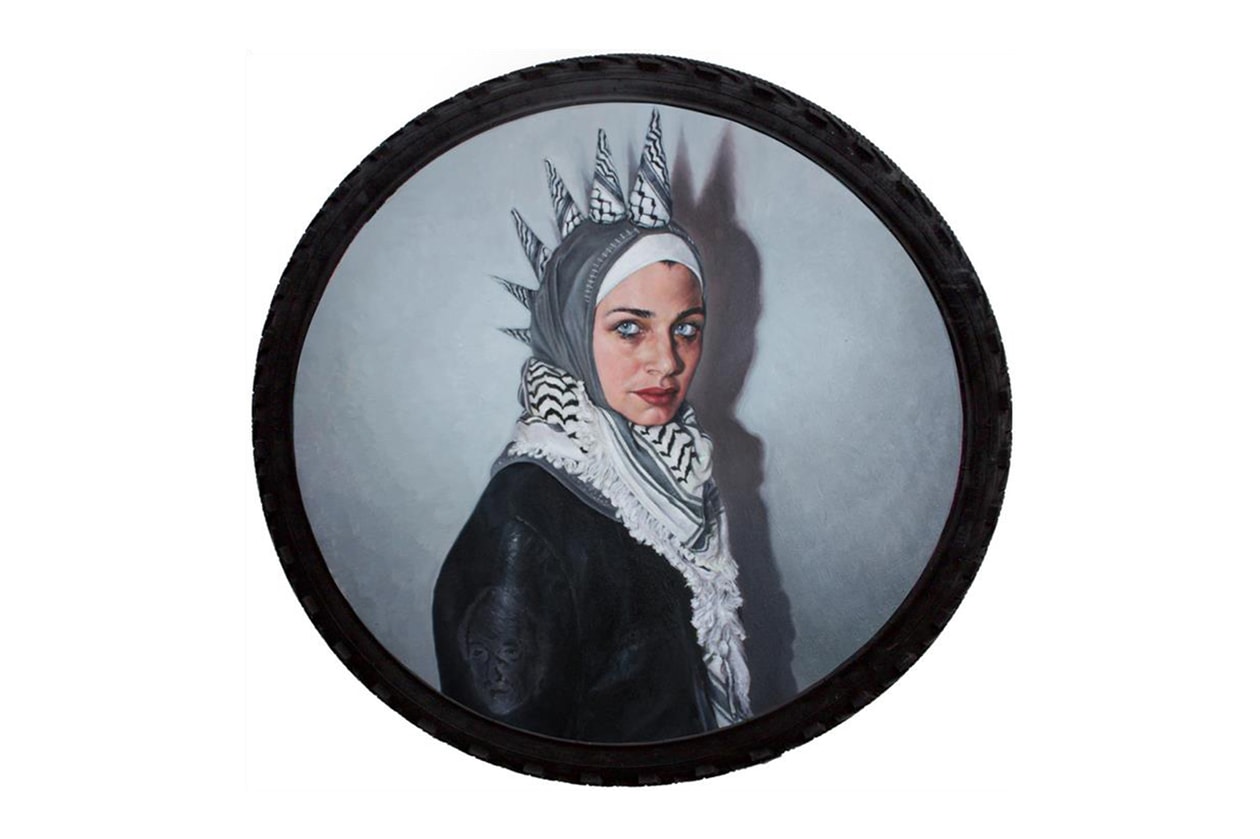
Last but not least is an artist who, in the spirit of Dismaland, took the meaning of protest one step further outside of his work. Palestinian native Shadi Alzaqzouq‘s pieces portray Muslim punks, subverting symbols such as the keffiyeh and, by association, the default image of urban Muslims as portrayed in Western media. One of six Arab artists within the original lineup of 58, Alzaqzouq staged a protest on the theme park’s third day after discovering that three other Israeli artists were exhibiting alongside him. Covering his works with a bedsheet that had written on it “R.I.P. Gaza” — referring to the continued Israeli blockade of the Palestinian territory — Alzaqzouq also lay down below his piece in the manner of a dead body. Understandably, the organizers of Dismaland were none too pleased about this, subsequently banning him from the premises, but his art — such as Helène Mohamed above — have been allowed to stay within Dismaland.












